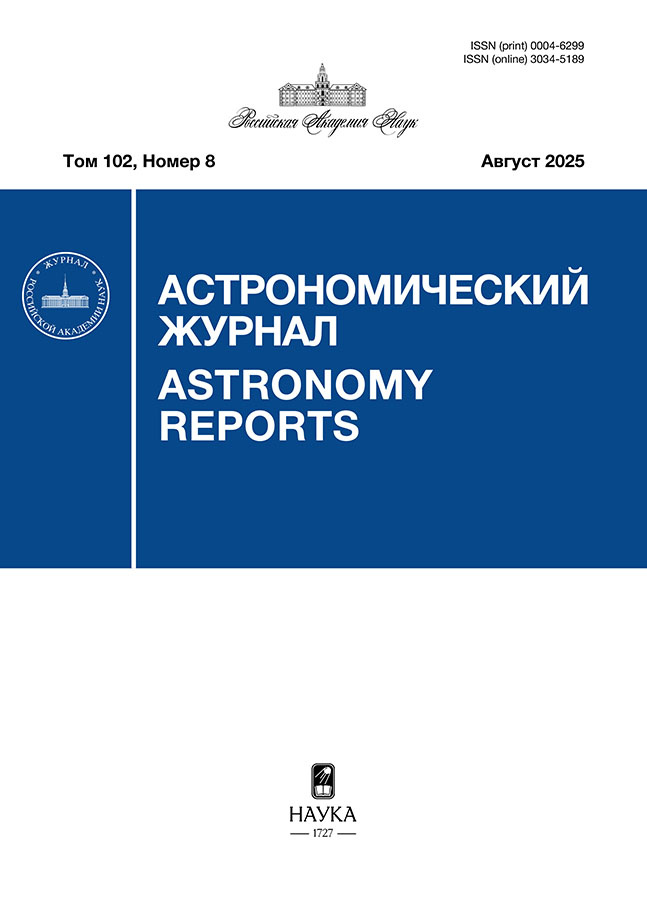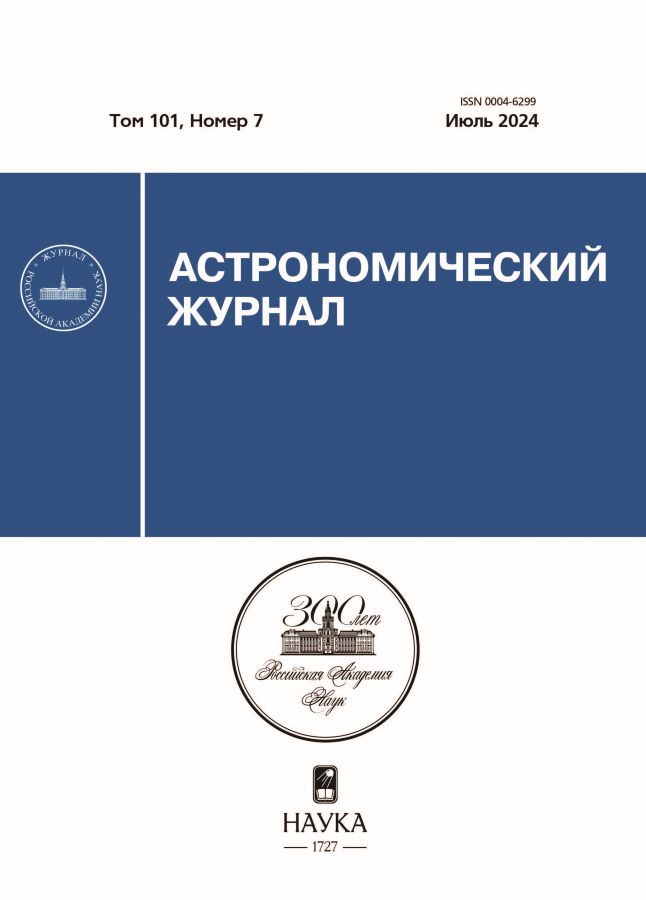Анализ причин магнитной бури 1–2 декабря 2023 года по наблюдениям межпланетных мерцаний на радиотелескопе БСА ФИАН
- Авторы: Лукманов В.Р.1, Чашей И.В.1, Тюльбашев С.А.1, Субаев И.А.1
-
Учреждения:
- Физический институт им. П. Н. Лебедева РАН
- Выпуск: Том 101, № 7 (2024)
- Страницы: 618-624
- Раздел: СТАТЬИ
- URL: https://rjmseer.com/0004-6299/article/view/647673
- DOI: https://doi.org/10.31857/S0004629924070037
- EDN: https://elibrary.ru/IUWPVQ
- ID: 647673
Цитировать
Полный текст
Аннотация
Приведены результаты анализа данных наблюдений межпланетных мерцаний, полученных на радиотелескопе Большая синфазная антенна Физического института им. П. Н. Лебедева (БСА ФИАН) перед началом, в период и после магнитной бури, произошедшей 1–2 декабря 2023 г. Проведено сравнение данных наблюдений с модельными расчетами для коротирующих и распространяющихся крупномасштабных возмущений. Результаты наблюдений мерцаний радиоисточников свидетельствуют о том, что имевшая место магнитная буря была вызвана наложением двух видов крупномасштабных возмущений солнечного ветра. В день перед началом магнитной бури наблюдались признаки взаимодействия магнитосферы Земли с коротирующей областью разноскоростных потоков солнечного ветра, тогда как позже наблюдались признаки возмущения магнитосферы выбросом корональной массы, распространяющимся после вспышки M9.8 28 ноября 2023 г.
Полный текст
Об авторах
В. Р. Лукманов
Физический институт им. П. Н. Лебедева РАН
Автор, ответственный за переписку.
Email: astrojourn@pran.ru
Астрокосмический центр, Пущинская радиоастрономическая обсерватория
Россия, ПущиноИ. В. Чашей
Физический институт им. П. Н. Лебедева РАН
Email: astrojourn@pran.ru
Астрокосмический центр, Пущинская радиоастрономическая обсерватория
Россия, ПущиноС. А. Тюльбашев
Физический институт им. П. Н. Лебедева РАН
Email: astrojourn@pran.ru
Астрокосмический центр, Пущинская радиоастрономическая обсерватория
Россия, ПущиноИ. А. Субаев
Физический институт им. П. Н. Лебедева РАН
Email: astrojourn@pran.ru
Астрокосмический центр, Пущинская радиоастрономическая обсерватория
Россия, ПущиноСписок литературы
- Ю. И. Ермолаев, И. Г. Лодкина, Н. С. Николаева, М. Ю. Ермолаев, М. О. Рязанцева, Космич. Исслед. 55, 189 (2017).
- M. M. Bisi, A. R. Breen, B. V. Jackson, R. A. Fallows, A. P. Walsh, Z. Mikic, P. Riley, C. J. Owen, A. Gonzalez-Esparza, E. Aguilar-Rodriguez, H. Morgan, A. G. Wood, M. Tokumaru, P. K. Manoharan, I. V. Chashei, A. Giunta, E. A. Jensen, J. A. Linker, V. I. Shishov, S. A. Tyul’bashev, S. K. Glubokova, M. S. Hamilton, J. M. Clover, K. Fujiki, S. E. Prise, B. Pinter, P. P. Hick and A. Buffington, Solar Phys. 265, 49 (2010).
- T. Iju, M. Tokumaru, K. Fujiki, Solar Phys. 289, 2157 (2014).
- M. M. Bisi, A. Gonzalez-Esparza, B. V. Jackson, M. Tokumaru and J. Leibacher, Solar Phys. 290, 2393 (2015).
- A. Johri, P.K. Manoharan, Solar Phys. 291, 1433 (2016).
- M. Tokumaru, M. Kojima, K. Fujiki, A. Yakobe, J. Geophys. Res. 105, 10435 (2000).
- M. Tokumaru, M. Kojima, K. Fujiki, J. Geophys. Res. 117, 06108 (2012).
- P. K. Manoharan, Astrophys. J. 751, 128 (2012).
- I. V. Chashei, V. I. Shishov, S. A. Tyul’bashev, I. A. Subaev, V. V. Oreshko, Solar Phys. 285, 141 (2013).
- A. Hewish, P. E. Scott, D. Wills, Nature 203, 1214 (1964).
- И. В. Чашей, С. А. Тюльбашев, Ю. В. Писанко, Метеорология и гидрология 46, 28 (2021).
- В. Р. Лукманов, И. В. Чашей, С. А. Тюльбашев, И. А. Субаев, Астрон. журн. 100, 535 (2023).
- В. Р. Лукманов, И. В. Чашей, С. А. Тюльбашев, И. А. Субаев, Астрон. журн. 100, 546 (2023).
- B. V. Jackson, H. S. Yu, P. P. Hick, A. Buffington, M. M. Bisi, M. Tokumaru, J. Kim, S. Hong, B. Lee, J. Yi, J. Yun, Astrophys. J. Lett. 803(1), L1, 5 (2015).
- В. И. Шишов, И. В. Чашей, В. В. Орешко, С. В. Логвиненко, С. А. Тюльбашев, И. А. Субаев, П. М. Свидский, В. Б. Лапшин, Р. Д. Дагкесаманский, Астрон. журн. 93, 1045 (2016).
Дополнительные файлы
















